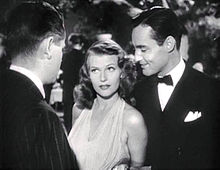Mark Roberts (actor)
Mark Roberts | |
|---|---|
 Mark Roberts (to the right of Rita Hayworth) in a trailer for Gilda | |
| Born | Robert Ellis Scott June 9, 1921 |
| Died | January 5, 2006 (aged 84) Los Angeles, California, U.S. |
| Other names | Bob Scott Robert E. Scott Robert Scott |
| Years active | 1938 - 1994 |
| Spouse | Audrey von Clemm (1953-1967) (divorced) (3 children) |
Mark Roberts (June 9, 1921 – January 5, 2006) was an American stage, film and television support actor who appeared in over 100 films between 1938 and 1994, according to the Internet Movie Database. Sometimes he was credited as Bob Scott, Robert E. Scott, or Robert Scott.
Early years
A native of Denver, Colorado, Roberts began acting when he was 4, appearing in a play in kindergarten. "The smell of greasepaint got me," he said years later.[1] During his childhood, the family moved to Lakewood, Ohio, and later to Kansas City, Missouri. Roberts attended Southwest High School in Kansas City and the University of Arizona at Tucson, where he majored in English.[1]
Film
Soon after Roberts graduated from college, a screen test at Columbia Pictures led to a long-term contract for him.[1]
Roberts made his film debut in Brother Rat, a 1938 film directed by William Keighley and starred by Ronald Reagan, in which he played an uncredited bit role as Tripod Andrews. After that, he was billed as Robert Scott in three films before obtaining his first and only leading role in the 1944 Columbia serial Black Arrow. He also served in the United States Army Air Forces during World War II. Following discharge, he acted under the name of Mark Roberts.
Roberts appeared (uncredited) in It’s a Wonderful Life, the 1946 classic Frank Capra film, in which he and Carl (Alfalfa) Switzer played Mickey and Freddie Othello, respectively, the two guys who unlocked the gym floor at the high school dance scene, exposing the pool below, where George Bailey (James Stewart) and Mary Hatch (Donna Reed) ended up taking a bath.
Stage
Roberts played the role of Dunbar in the Broadway production of Stalag 17 (1951).[2] Concurrently, he was a member of the cast of Miss Susan, a television serial. The dual responsibilities mean that Roberts usually left New York City via train at 8 a.m. going to Philadelphia for rehearsals and the program's live broadcast. Then he caught a 6:06 p.m. train back to New York to perform in the play.[3]
Television
Roberts later became a familiar face in selected drama and action television series. He starred as reporter Hildy Johnson in the 1949-1950 syndicated television series The Front Page. In the 1960-1961 season, he joined Stephen Dunne (1918–1977) as fictitious brothers playing private detectives in the syndicated television series, The Brothers Brannagan,[4] which aired 39 episodes. Roberts played Bob Brannagan; Dunne, Mike Brannagan. He made seven guest appearances on Perry Mason, including two 1962 roles as the murder victim: title character Otto Gervaert/Gabe Phillips in "The Case of the Absent Artist," and Tod Richards in "The Case of the Playboy Pugilist."
Roberts made his last screen appearance in the short-lived 1994 sitcom Monty.
Personal life
Roberts married Audrey Von Clemm in Philadelphia, Pennsylvania, in 1953.[1]
Death
Roberts died at the age of 84 in Los Angeles, California. He is survived by his three children.
Selected appearances
Partial filmography
- Brother Rat (1938)
- One Mysterious Night (1944)
- The Crime Doctor's Courage (1945)
- A Close Call for Boston Blackie (1946) uncredited
- The Unknown (1946)
- Life with Blondie (1945)
- The Notorious Lone Wolf (1946)
- Gilda (1946)
- Shadowed (1946)
- It's a Wonderful Life (1946)
- Dead Reckoning (1947)
- Shed No Tears (1948)
- The Unknown Man (1951)
- The Pride of St. Louis (1952)
- The Buster Keaton Story (1957)
- Last Train from Gun Hill (1959)
Serials
- Black Arrow (1944)
Television
- Kraft Television Theatre (1949–1958)
- Miss Susan (1951)
- Three Steps to Heaven (1953)
- The Philco Television Playhouse (1954)
- Studio One (1954)
- Robert Montgomery Presents (1955)
- The Alcoa Hour (1955)
- Letter to Loretta (1956–1960)
- Cheyenne (1957)
- Gunsmoke (1957)
- Perry Mason (1957–1965)
- The Millionaire (1958)
- Richard Diamond, Private Detective as Rod Leighton in "Bungalow Murder" (1958)
- M Squad (1959)
- 77 Sunset Strip (1959)
- Alcoa Presents: One Step Beyond (1960)
- Surfside 6 (1961)
- Adventures in Paradise (1961)
- Follow the Sun (1962)
- The Outer Limits (Episode: "The Hundred Days of the Dragon") (1963)
- General Hospital (1963)
- 12 O'Clock High (1966)
- The F.B.I. (1966–1969)
- The Invaders (1967)
- Ironside (1968)
- Dan August (1970–1971)
- Barnaby Jones (1973–1975)
- Doctors' Hospital (1976)
- The Rockford Files (1978)
- Dynasty (1987)
- Dark Justice (1993)
References
- ^ a b c d "Bother Brannigan Recalls: 'I Always Wanted to Act'". The Daily Herald. Utah, Provo. November 14, 1960. p. 21. Retrieved May 20, 2016 – via Newspapers.com.

- ^ "Stalag 17 - Cast". Playbill Vault. Retrieved 23 May 2016.
- ^ Toomey, Elizabeth (July 1, 1951). "Actor Plays One Role At Night, Another In Day". The High Point Enterprise. North Carolina, High Point. United Press. p. 17. Retrieved May 20, 2016 – via Newspapers.com.

- ^ Erickson, Hal (1989). Syndicated Television: The First Forty Years, 1947-1987. McFarland & Company, Inc. ISBN 0-7864-1198-8. Pp. 107-108.
